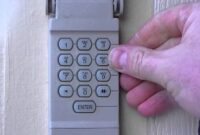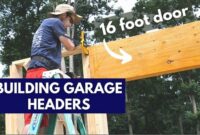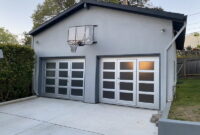Contents
Tips For Installing Garage Door Seals GarageDoorSalesNearme.Com | If you’ve decided that it’s time to replace the bottom garage door seal, here are some tips.
First, determine what type of seal you’re replacing. Then, check your garage door for damage or leaks. Lastly, follow these steps to install a new seal.
Let’s get started. Read on to learn more. After you’ve selected the correct seal, install the new one. If you’re unable to complete the task on your own, ask a friend or family member to help you.
Tips For Installing Garage Door Seals
#Replace bottom garage door seal
There are a couple of ways to replace the bottom garage door seal. The new one is typically screwed into place, so you’ll want to carefully unscrew it.
Once you’ve unscrewed the seal, you’ll need to fold it over and pull it through the bottom retainer channels. Pulling the seal tightly will help keep it in place, but it may also shrink as it dries, so be sure to follow manufacturer’s instructions.
The first thing to do when replacing your bottom garage door seal is to determine the type of seal you need. Different manufacturers have different sizes, so check the measurements of your door to see which one you need.
If you find that you have a small gap, a 7-inch seal will work just fine. For larger gaps, you can use a 7-inch seal, but make sure to measure the thickness of your garage door.
If you have a large gap, you can use a bottom seal retainer to cover the gap. This is the simplest solution and costs very little. The retainer is made from rubber, so you can buy it at a garage parts supplier.
Then, install it in the appropriate spot on the bottom panel of your door. To prevent future gaps, make sure the top edge is caulked and painted to match the rest of the door. Both metal and wood doors can benefit from this solution.
Before starting, clean the track that runs the bottom of your garage door. If the seal is screwed into place, you may find it difficult to feed it through the track.
If this is the case, use a flathead screwdriver or a sharp blade of a knife to open the end section of the track. If you’re not confident in your skills, you can ask a friend to hold the seal while you thread it through the track. Make sure the seal is level and folded widthways, so that the t-shaped sections slide into the track.
Once you have located the bottom garage door seal, you’ll need to measure the width, height, and thickness of your door to determine which type to choose. Generally, rubber garage door seals will work well in most climates.
But if you live in an extreme climate, you might want to choose a silicone garage door seal. If you’re uncertain, you can ask your local hardware store for one. They should have it in stock.
Tips For Installing Garage Door Seals
#Determine type of seal
First, you need to determine the type of garage door seal your garage has. If you’re unsure, a few pictures of your existing door should help you determine the kind of seal you have.
The bottom seal is a T-shape that folds inward when the door is closed. Then, you’ll want to measure the width of the door and the seal itself. If your door is made of wood, you’ll want to check the size of the seal.
If your door is made of wood, the bottom seal is a U-shape. To replace this seal, you’ll need to measure the width, height, and thickness of your door.
Rubber garage door seals are typically the most common, but silicone ones are ideal for colder climates. You should always measure the door before you buy a new one, as different sizes have different specifications. Once you’ve measured the dimensions of the door, you’ll be ready to purchase a replacement weather seal.
A standard 20-foot-long, 3.75-inch-wide rubber garage door seal will fit all of the major brands of garage doors. These seals are able to withstand uneven floors.
They’re easy to install and strong enough to support heavy vehicles. While they aren’t the most durable seals, they’re still able to provide the same level of protection. You’ll need to purchase a replacement bottom track separately.
Another option is a brush seal. These seals have thousands of hard bristles that prevent debris from entering the door. They can prevent rust, but they do cause friction.
Commercial and sheet doors require a reverse angle mount track. A vinyl door seal won’t work on steel jambs. A special seal is needed.
If your garage door is made of wood, the top seal will fit. However, the bottom seal won’t fit on your garage door if it has steel jambs.
Once you know which type of garage door seal is needed, you can begin the replacement process. First, disengage the opener and lift the door 6 feet off the ground.
Next, use a pair of C clamps to secure the track in place. Then, use a hammer to hammer the seal into place. You may also need to use a flathead screwdriver to open the end section.
Tips For Installing Garage Door Seals
#Check for leaks
During heavy rain, a garage door’s seal can start to wear and cause leaks. To find leaks, simply open the garage door and splash water against it. If water flows in and out, this indicates a problem with the seal.
If water continues to leak into the garage, it will likely be a sign of a broken seal. If water is moving into the garage during the night, the seal is likely compromised.
If your garage door’s seal is old, it may be time to replace it. Older seals may have worked until recently, but they are no longer effective and should be replaced.
The bottom seal is usually made of rubber, which tends to shrink, crack and become rigid over time. It will begin to leak and not work as efficiently as it once did. Replace the seal to keep water out and drafts out of your garage.
If you have a new garage door, be sure to check it for leaks. These gaps will let sunlight and warm air inside the garage. Make sure to look for gaps before installing a new one.
Make sure to remove any debris that may have accumulated in the area. A cracked seal will allow water and debris into the garage, which is dangerous. If the seal has been damaged, it is time to replace it.
One of the most common reasons for leaks under a garage door is a broken seal. A broken or worn rubber gasket prevents the door from sealing tightly.
This causes water and moisture to drip under the door and may also allow insects and animals to enter. Replace the seal if it is faulty, but don’t forget to check your garage’s drainage. Having gutters installed around your home can help prevent excessive water from collecting under the garage door.
Installing a new garage door seal should be a simple process. The first step is to measure the door threshold to determine the size of the seal.
If there is one, you can buy a threshold seal, which is a no-drill solution. Threshold seal kits contain everything you need to install the seal. A garage door seal is an essential part of your garage’s security.
Tips For Installing Garage Door Seals
#Check for damage
A damaged garage door seal may point to a larger problem with the structure of the garage door. Homeowners may not notice rotting trim or hinge problems, so they may not immediately realize that there is a problem with the seal.
Failure to repair a larger problem may lead to even more expensive repairs down the line. In such cases, it is often better to replace the entire door rather than making piecemeal repairs. There are many potential culprits.
To find out whether the seal is damaged, check the seal’s bottom edge. A light stripe can be placed on the bottom edge to check for drafts and light sources.
If the tape flies, there is a problem with the weather stripping. If you notice flying tape, fix the weather stripping and make sure it doesn’t cause another problem.
When installing a new garage door seal, remember to replace the damaged sections and replace the door’s weather stripping as needed.
Inspect the door after a heavy rain, or if it has been damaged by another issue. If the seal is prone to leaks, you should take it to a professional immediately.
Inspecting the seal may take a little time, but it’s well worth it when you’re dealing with a potentially costly situation. A properly-functioning garage door seal can prevent unexpected flooding in your garage during a winter storm.
If your garage door has been exposed to the elements for many years, the bottom seal may have been damaged. This can allow squirrels and chipmunks to get inside.
A replacement seal will prevent this from happening again. Also, a new garage door seal can prevent your garage from being infested by pests. Check the garage door seal for leaks to avoid having pests in your garage. You’ll never know when you may need it!
Another thing to look for when installing garage door seal is damage to the bottom portion of the garage door. The bottom part of the seal is attached to the bottom of the door, and many products use adhesive to stick them in place.
Make sure that you carefully remove any debris that might be affecting the integrity of the seal. In addition to a damaged bottom section, there may be a gap between the sides of the garage door and the seal. This could be a result of regular wear and tear or structural shifting.



